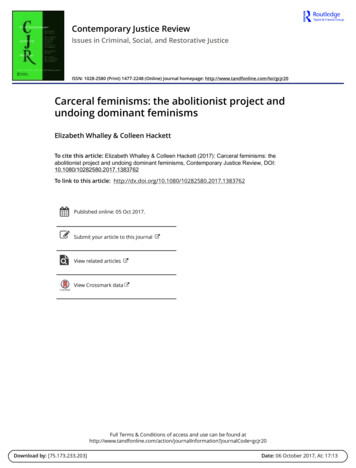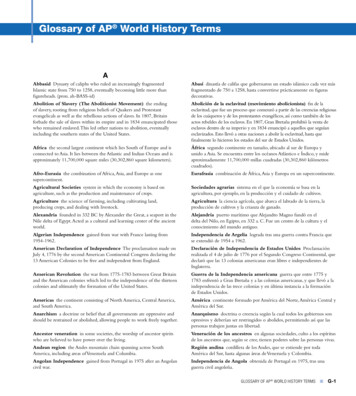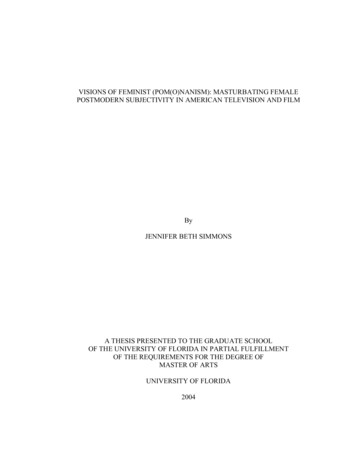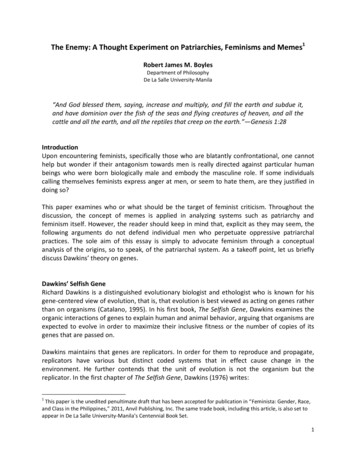
Transcription
Contemporary Justice ReviewIssues in Criminal, Social, and Restorative JusticeISSN: 1028-2580 (Print) 1477-2248 (Online) Journal homepage: http://www.tandfonline.com/loi/gcjr20Carceral feminisms: the abolitionist project andundoing dominant feminismsElizabeth Whalley & Colleen HackettTo cite this article: Elizabeth Whalley & Colleen Hackett (2017): Carceral feminisms: theabolitionist project and undoing dominant feminisms, Contemporary Justice Review, DOI:10.1080/10282580.2017.1383762To link to this article: lished online: 05 Oct 2017.Submit your article to this journalView related articlesView Crossmark dataFull Terms & Conditions of access and use can be found tion?journalCode gcjr20Download by: [75.173.233.203]Date: 06 October 2017, At: 17:13
Contemporary Justice Review, arceral feminisms: the abolitionist project and undoingdominant feminismsElizabeth Whalleya and Colleen HackettbaDepartment of Sociology at Framingham State University, Framingham, MA, USA; bDepartment of Sociology,Colorado State University, Pueblo, CO, USADownloaded by [75.173.233.203] at 17:13 06 October 2017ABSTRACTIn this article we explore the intersections between white liberalfeminisms and the carceral state, particularly within nonprofitagencies. We find a strong collusion between ‘dominating feminisms’and the carceral state, through funding structures and the belief thatthe legal system can provide protection to victimized women. We useevidence from our own research on rape crisis centers and genderresponsive programming for criminalized women, respectively, toinvestigate how some nonprofit agencies further threaten the safety,stability, and self-determination of women of color, queer women,transgendered clients, economically disadvantaged women, anddisabled women. As a result, when white liberal feminists seek tointervene in the criminal legal system, we often see reform effortsthat directly strengthen institutions that perpetuate economicexploitation, colonialist notions of progress, and white supremacy.We conclude our article with an exploration of some guidingprinciples within noncarceral antiviolence organizations that espousea liberatory feminist framework.ARTICLE HISTORYReceived 16 August 2016Accepted 5 September 2017KEYWORDSFeminist theory; prisonabolition; critical prisonstudies; feminist criminology;critical criminology;antiviolence movementIntroductionAlthough criticisms of the penal system have been circulating among marginalized communities for several decades, the US is now witnessing a peculiar historical moment in whichbipartisan political alliances and white publics are adopting similar critical assessments.Popular critiques often place the blame for the overreliance on incarceration on conservativelaw-and-order politics and overt white animus towards ‘dangerous’ racialized others, suchas the Reagan-era crack-cocaine laws and their attendant moral panics. Many in the academicand activist communities are celebrating this shift in rhetoric, viewing it as an opportunityto enact substantive change in penal policy. Yet we wish to add to the growing analysis thatpoints to the complicity of liberal political agendas in grossly expanding the prison systemin the US (Beckett & Murakawa, 2012; Murakawa, 2014; Schept, 2015). In this article, weexplore the ways in which carcerality, as a system and a set of logics that are deeplyentrenched in gendered racial frameworks, is mobilized by and expanded through liberalfeminist discourses.CONTACT Colleen Hackettcolleen.hackett@csupueblo.edu 2017 Informa UK Limited, trading as Taylor & Francis Group
Downloaded by [75.173.233.203] at 17:13 06 October 20172 E. WHALLEY AND C. HACKETTIn particular, we explore the role that hegemonic and dominating feminisms play inemboldening carceral systems of racialized social control as a way to combat genderedviolence and to soften the effects of the prison system on women’s lives. We define ‘dominating feminisms’ as a version of feminism that seeks to leverage formal institutional powers– including the carceral state – vis-à-vis a white supremacist state order with the hope ofsecuring equality between (cis-gendered) men and women. This articulation of feminismcatapulted the issues of sexual and gender violence into cultural discourse during the ‘secondwave’ of feminism during the 1960s through the ‘80s. Many feminists of this era contestedthe idea that sexual and gendered violence were private and individual matters, positioningsuch behaviors instead as public and political issues. As a result, mainstream and largelywhite feminist organizations, such as the National Organization for Women, arose to addresssuch issues and to reform institutions that enabled and perpetuated patriarchal violence.In appealing to the state for greater access to legal rights and more protection, mainstreamfeminist organizations continue to believe that a successful intervention to patriarchal violence for ‘all’ (white and cis-) women can be secured through legislation, greater police presence, and a general expansion of penal power. It is both the failure of these organizationsto interrogate their own use of structures of oppression as well as their complicity in statepractices of oppression that render their feminisms ‘dominating’ – as opposed to liberating.While such a conceptualization encompasses many different systems, in this article we usethe examples of rape crisis centers (RCCs) and gender-responsive programming for criminalized women as organizations that outwardly purport to acknowledge the role of interlocking oppressions while covertly advancing mainstream, white feminist agendas.After defining and problematizing dominant feminisms, state protectionism, and thegrowth of the carceral state, we focus our analysis on three points. First, we point to the roleof legislation and continued rhetorics in anti-rape organizations and scholarship in maintaining implicit preference for white, middle-class, heterosexual cis-women populations(Bumiller, 2008; Corrigan, 2013; Matthews, 2005; Stringer, 2014). By aligning with the victimology of the criminal within the criminal legal system, anti-rape organizations uphold theneed for carceral control to disrupt gendered violence. Second, we discuss the ways in which‘gender-responsive programming’ for criminalized women (Bloom, Owen, Covington, &Raeder, 2002), despite its benevolent intentions, renders certain marginalized populationsas ‘dysfunctional’ and legitimates the function of the penal system to intervene in welfaristconcerns (Heiner & Tyson, 2017; Musto, 2016). Third, we focus on the importance of community in fighting for liberation from white supremacist heteropatriarchal social orders andthe carceral state. In expanding collective notions of ‘safety,’ we consider more liberatoryfeminist options in the efforts to deal with heteropatriarchy and the interpersonal and stateviolences that arise from structures of domination.In our examination into the complicity of feminist nonprofit agencies in expanding thereach of the carceral state, we borrow a conceptualization of the ‘shadow state’ from Wolch(1990). The shadow state is mechanized through the increasing role of governmentally controlled nonprofit agencies in administering direct social services cut by the neoliberal deregulation of capitalism (see also Beckett & Murakawa, 2012). Within the shadow state, dominantfeminist organizations do not only serve the state, but also come to resemble the capitalistheteropatriarchies within it. Building from Wolch’s concept in The Revolution Will Not BeFunded, the INCITE! organization (2007) outlined the existence of the ‘non-profit industrialcomplex’ (NPIC), which Dylan Rodríguez defined as ‘a set of symbiotic relationships that link
CONTEMPORARY JUSTICE REVIEW 3Downloaded by [75.173.233.203] at 17:13 06 October 2017together political and financial technologies of State and owning-class proctorship andsurveillance over public political discourse’ (2007, pp. 21–22). INCITE! critiqued the NPIC asa trillion-dollar industry that performs the work of the state by keeping forms of inequalityin place (Rodriguez 2007). The organization points to the proliferation of neoliberal capitalismas linked to the rise of the NPIC. The financial instability of neoliberal capitalism pushesdominating feminisms further into reliance on state structures. By latently supporting theseagencies, the US government secures oversight and decision-making authority over organizations that might otherwise be oriented towards social justice aims and pacifies the communities that are most affected by federal cuts. In their discussion of how the US progressivemovement’s agenda misdirects SJ movements, Lethabo King and Osayande (2007, p. 81)characterized social justice (SJ) organizations within the NPIC as such: many white-led social justice non-profits proclaim, in everything from their mission statements to their funding proposals, that they are committed to improving the social and economicconditions of the oppressed communities in which they operate. But alongside these proclamations exists a persisting hierarchy and circulation of capital within the social justice movement.RCCs and gender-responsive reentry programs are within this shadow state NPIC. Whilemaking claims to identifying with SJ work, the organizations are representative of government-backed services that are regulated by both grant requirements and their affiliationwith the courts and mental health systems.Dominating feminisms believe in the neutral force of the legal system to meaningfullyredress social problems and gender inequalities (Schneider, 1986). Using these logics, popular movements and mainstream (white) feminist organizations have pushed to leveragestate power in order to achieve their political aims. Neoliberal cuts to social services havepushed mainstream feminist organizations into dependent relationships on state fundingand state solutions, which at once adheres to and displaces the responsibility for state violences (INCITE!, 2007). Divorced from an analysis of colonization, state repression, and otherforms of state-sponsored violence, dominating feminisms believe in the promise of democratic rights vis-à-vis the legal system. Yet, the notion that the US legal system can providefreedom, equality, and protection for all frequently elides past and present examples oflegalized heteropatriarchal racism. A calculus of human worth has been – and still is –encoded into US law that sorts and ranks people based on their closeness to or distancefrom the ‘desirable’ citizenship status of white or white-assimilating, heterosexual and gender-conforming, middle- or upper-class, and employable (Jung, 2011). The US’s use of segregation laws targeting racialized bodies, sodomy laws regulating ‘deviant’ or ‘queer’sexualities, bathroom policies that demonize transgendered individuals, and the forcedsterilization of incarcerated women, to name just a few examples, demonstrate the tendencyfor the legal system to encode a hierarchical ordering of bodies, targeting those at the bottomof the social ranks for surveillance, exclusion, and/or violence (Cacho, 2012).As an advanced liberal democratic nation, the US legal system is supposedly predicatedon the personhood and moral equivalence among its citizens, yet access to state protectionis differentially assigned based on citizenship status, gender, race/ethnicity, age, sexuality,and physical ability. Moreover, as political philosopher Charles W. Mills observes, the legalpresumption of moral egalitarianism ‘conceals the dominant role of one subset of humans(white males) in the shaping of the modern world; and the accompanying denial of equalmoral status to the majority of the population in the resulting modern sociopolitical order’(2011, p. 37). Liberalism, therefore, is often a façade that masks material and power
Downloaded by [75.173.233.203] at 17:13 06 October 20174 E. WHALLEY AND C. HACKETTdifferentials between groups by rhetorically promoting ‘equal rights,’ yet does little to unearthand remedy structural inequities. Both liberal and conservative forces produce and maintainasymmetrical power relations between differentially situated groups; yet the liberal call for‘fairness’ often accelerates the powers of the punishing state to capture more bodies insteadof scaling back or offering protection through different means (Murakawa, 2014, p. 15).Relatedly, Spade (2013) addresses how the ‘discrimination principle’ within much of civilrights legislation fails to address the structural violences enacted by the state, particularlythose of white supremacy. The state is unable to provide equal protection and non-discrimination to those within its borders because the state itself enshrines white supremacy, heteropatriarchy, and transmisogyny into its legal codes – a structure that operates throughnonconsensual imposition, coercion, and at many times, brute force. Although there is someamount of discussion among mainstream feminists about the ways in which US socio-legalsystems were built by and for white heteronormative men, they continue to push for superficial reforms of state power with the belief that eventually, equality will trickle from the topdown.Dominating feminisms are inattentive to the ways in which heterowhiteness is encodedinto law; therefore, these ‘feminist’ frameworks fail to consider the myriad ways that powerand oppression operate on and through differentially situated women (Aziz, 1992). Due tothe ahistorical understanding of the state and the ways it reinforces gendered-racial disempowerment, dominating feminists continue to trust in the state to offer protection to thosevulnerable to patriarchal violence. Those who adhere to such a power-evasive frame appealto the criminal legal system to intervene in violence against (cis-) women by implementingand/or enhancing penalties against ‘perpetrators.’ The carceral turn in feminism, particularlyon issues related to patriarchal violence, has coincided with and reflected the neoliberalstate apparatuses that govern racialized and poor bodies through crime (Bumiller, 2008;Simon, 2006). Bernstein notes in her conceptualization of carceral feminism, as it relates toanti-trafficking movements and laws that, ‘Rather than pursuing materially redistributivestrategies, the versions of feminism that have survived and thrived are those that deploythe mutually reinforcing sexual and carceral strategies that a reconfigured neoliberal stateis likely to support’ (2012, p. 254). Carcerality is a constituting logic within US society, as wellas beyond its borders, and is problematically accelerated through and legitimated feministorganizations within the shadow state, leading to an amplification in policing and penality.The cries for enhanced protections for battered, victimized women often exercise an overreliance on outsourcing safety to the criminal legal system, constituting a type of ‘carceralprotectionism’ that blends punishment with ‘care’ for survivors and victims (Musto, 2013,2016).Yet, as Victoria Law observes of dominant feminist frameworks, ‘This stance does notacknowledge that police are often purveyors of violence and that prisons are always sitesof violence’ (2014). Because of the lack of historicizing and problematizing the state and itsrole in upholding heterowhiteness, dominating feminisms mobilize penal interventions toprotect some women at the expense of many women. Using the prison system and othermethods of formalized social control to gain protection from the state mobilizes additionalviolences in marginalized women’s lives. Carceral feminisms deploy narrow definitions ofviolence that focus on private abuses committed against (cis-) women within heterosexualrelationships or among family members (Price, 2012), omitting the violences committed byimmigration raids and detention centers, policing of poor communities of color, and johns
Downloaded by [75.173.233.203] at 17:13 06 October 2017CONTEMPORARY JUSTICE REVIEW 5who buy or trade sex from cis- and transwomen. Police and prisons perpetuate hazardous,racialized violence against women of color, queer women, transwomen, and economicallydisadvantaged women (INCITE!, 2006).In appealing to the carceral state, mainstream liberal feminists claimed – and continueto claim – to represent all women, while including only the voices of elite white women(Alexander & Mohanty, 2010). These (mis)representations work to exclude many women,most often women of color, women with low socioeconomic statuses, Indigenous women,and transwomen (Crenshaw, 1993; Davis, 1981; Deer, 2015). This brand of feminism oftenflattens difference and articulates a politics of ‘sameness’ in which all (cis-) women are subjected to patriarchal violence in similar ways (Price, 2012). This political craftwork is for thesake of promoting a unified message, yet it evades a power-conscious analysis. Rhetoricallyframing a social movement and agenda in a way that addresses similarities may be strategicat times, yet dominating feminisms dilute critiques of patriarchy and ignore the interlockingeffects of race, sexuality, gender non-conformance, class, indigeneity, legal status, and ability.As a result, mainstream feminist groups and organizations often drown out the more radicaltendencies of liberation-based and women-of-color feminist groups, arguing that race orclass frameworks might ‘detract’ from ending gendered violence. By relying on imprisonmentto solve social problems instead of learning from social movements (Gilmore, 2007), dominating feminisms work to expand the carceral state through a white liberal frame that ignoresan analysis of power and oppression. We will explore two ways in which the feminist arm ofthe state mobilizes penal power: sexual assault response and gender-responsive programming. We conclude this paper with discussing social movement -based interventions toaddress heteropatriarchal and white supremacist systems of domination in an attempt toundo the damage done by the carceral state and dominating feminisms.Sexual assault responses and rape crisis centersDominating feminisms’ normative treatment of sexual violence hinges ‘legitimate’ victimstatus to engagement within state institutions. As a result, mainstream feminist academicsand anti-rape organizations reinforce the existence of these power structures and view retributive punishment as the solution to sexual violence, mandating the need for the prisonindustrial complex. Taken together, the treatment of sexual violence by dominating feminisms fails to examine the root causes of such abuse and effectively supports the criminallegal system’s exploitation of rape tropes to justify mass incarceration.Rape crisis centers (RCCs) were first established during the second wave of feminism asexplicitly feminist grassroots organizations, and are seen as representative of the mainstreamanti-rape movement (Enke, 2007; Gornick, Burt, & Pittman, 1985; Maier, 2008). The first RCCsrejected anti-feminist notions of bureaucracy and hierarchy in favor of community and collectivity, and were notably in opposition to the police and legal systems that had historicallymistreated and abandoned victims (Byington, Martin, DiNitto, & Sharon Maxwell, 1991; Maier,2011). This anti-authoritarian stance radically shifted in the decades following, and mainstream anti-rape activism is now closely aligned with the criminal legal system and carcerallogics. Increasing neoliberalization severely reduced funding to anti-rape services in the1990s and 2000s, and after the passage of the Violence Against Women Act in 1994, availablefunding was tied to evidence-based governmental grants and associations with state-affiliated institutions (Bumiller, 2008). In the face of such state dependency, RCCs began
Downloaded by [75.173.233.203] at 17:13 06 October 20176 E. WHALLEY AND C. HACKETTtrading-off their anti-establishment missions in favor of financial stability, using bureaucraticstatus markers to establish their legitimacy with state-endorsed systems they rely upon(Martin, 2005).In addition to situation of RCCs within the aforementioned NPIC, we view the matrix ofsystems that respond to sexual assault (hospitals, law enforcement, and court systems) as asexual assault response complex. In order to display legitimacy and productivity for funders,RCCs have moved away from alternative healing, education, and prevention in favor ofincreasing provision to formal institutions within this complex. For example, in 1995 virtuallyall RCCs in the US listed a locally run crisis hotline among their services (Campbell, Baker, &Mazurek, 1998). Over three years of ethnographic field research over four years at a US rapecrisis center in the Western United States, the first author observed the 24/7 volunteer hotlinebecome outsourced to a national response line in order to allow the center to focus exclusively on response to police and hospital calls. In the brief explanation to staff and volunteers,the center’s leadership emphasized the importance of a dependent relationship with thepolice and district attorney over the need for a localized response to victims.Given the context of the US private healthcare system, sexual assault response could alsobe viewed as a sexual assault response industrial complex, in that carceral systems profitfrom violence occurring. In utilizing the healthcare system for rape response, multiple industries profit from the perpetual cycle of sexual violence. During the process of a forensic sexualassault exam at the hospital, victims are disembodied as their bodies are catalogued andtransformed into crime scenes, with the forensic collection of evidence prioritized over thedesires and boundaries of the victim (Mulla, 2014). Having been instructed not to eat, drink,urinate or bathe before the exam, victims regularly wait for four to six hours in emergencyrooms for their exams. Following the exam, victims are regularly sent medical bills withthousands of dollars in charges. While such exams are ultimately paid for by the state orprivate insurance, this knowledge of deferred payment depends on the impetus of the victimor RCC advocate: if the victim is not informed, they may believe they must pay the bill themselves. Samenna Mulla (2014) drew such a connection in her analysis of sexual assault emergency room responses, finding the economics of healthcare played out between hospitalstaff, rape crisis advocates, and sexual assault victims, which turned hospital staff into legalarbitrators of the state, determining legitimacy of victims to ‘state-sponsored’ medical service.In her discussion of how the prison industrial complex permeates culturally, Angela Davis(2016) implicates mass incarceration and health care industry as both linked to the commodification of human services through the destructive force of global capitalism. Sexualassault response is similarly linked to such commodification. Within the sexual assaultresponse complex, the profit margin from pain is enormous.As Rose Corrigan (2013) discusses in her study of RCC advocates, many RCCs have stoppedpublicly presenting themselves as feminist organizations in an effort to improve their perception by criminal legal systems. Shana Maier’s (2008) analysis of the role of feminism inmodern RCCs found that while the majority of RCC directors identified their centers as feminist, they were often hesitant to use the label of feminism due to the possibility of alienatingvictims, advocates and funding sources. Within the field research at an RCC conducted bythe first author, this RCC ‘covert’ feminist identification was justified by management aspromoting greater inclusivity to potential male clients. By making claims to feminism, socialjustice, and social movements intra-organizationally and with other social justice organizations, RCCs propagate dominating feminisms while serving a historically dominant sex
Downloaded by [75.173.233.203] at 17:13 06 October 2017CONTEMPORARY JUSTICE REVIEW 7categorization. Corrigan (2013) described this carceral entanglement as a convergence ofconservative and feminist interests, reaffirming the importance of state logics even as feminists were citing such systems as causing and maintaining gender violence. Such a strategyremoves the political charge of both RCCs and anti-rape work, rendering the sexual assaultresponse complex to focus entirely on crime management – or, as Nancy Matthews (2005)termed it, ‘managing rape’ rather than preventing it. In her analysis of rape law and feministactivism, Aya Gruber (2009) delineates the progression of the anti-rape movement awayfrom awareness-raising and towards supporting the criminal legal system, describing how‘the subsequent decades-long entanglement with criminal justice systems have fundamentally re-defined the movement’s internal goals’ (8). By creating a dependent relationshipbetween RCCs and formal reporting systems, the state apparatus gained the dedicatedsupport of their one-time critics, and dominating feminisms aligned their visions with ‘lawand order’ ambitions.Now established as rank-and-file elements of the sexual assault response complex, mainstream feminist organizations promote reporting as the solution to sexual violence, imbuingpower into criminal legal institutions. In exposing the ‘invisibility’ of sexual abuse during thesecond wave, mainstream feminism often fell into infantilizing tropes of victimhood, portraying those who experienced abuse as a person who was broken, traumatized, and in needof care (Chasteen, 2001; Mardorossian, 2014). In their study of perceptions of sexual assaultvictims in the general population, Gavey and Schmidt (2011) proposed this perception represented a ‘trauma of rape’ discourse: rape was seen as a devastating violation, worse thandeath, that took public processing to recover from. As this conception of rape entered publicconsciousness, victim legitimacy became dependent on victim compliance within the protective authority of the criminal legal system.While RCC advocates are trained to be neutral facilitators while a victim determines ifthey will report their assault, there remains an implicit pro-institutional preference: duringparticipatory research as a RCC hotline advocate, the first author and fellow advocates weretrained to question the rationale of victims who suggested they did not want to report, andwere not given similar instructions for victims who showed proactive interest in filing areport. During a later meeting between campus police and rape crisis advocates, an officerdiscussed the difference between being a victim and a survivor: ‘They’re victims, not survivors, until they go through my process.’ Here, victimhood is positioned as a negative termindicating regression: healing can only come through engaging with carceral systems.Dominating feminist scholarship on victims who do not engage the criminal legal systemsubtly perpetuates this glorification of formal reporting. Approximately ten percent of sexualassaults are reported to the police (Fisher et al., 2000). Rather than analyzing how the legalsystem may not serve victims, dominating feminist scholarship examines how victims canbetter serve the legal system, often framing victims as being in ‘denial’ (Paul et al., 2013;Weiss, 2011). Those who experience sexual assault are frequently divided by both scholarshipand anti-rape organizations into groups of ‘unacknowledged’ and ‘acknowledged’ victims(i.e. Kahn, Jackson, Kully, Badger, & Halvorsen, 2003; Layman, Gidycz, & Lynn, 1996). In JudithHerman’s widely popular book Trauma and Recovery (1997), Herman compared the mindsetof trauma victims to that of children who, by this logic, are to be cared for by the paternalstate. This reinforcement of institutional structures is in lockstep with governmental andbureaucratic perspectives that promote carceral logics.
Downloaded by [75.173.233.203] at 17:13 06 October 20178 E. WHALLEY AND C. HACKETTCurrent public discourse of sexual violence exclusively serves the interests of the rulingclass and dominating feminisms, maintaining heteropatriarchal structures. Mainstream feminist efforts have propagated political action on the issue of campus sexual assault, as seenin the ‘It’s On Us’ nationwide campaign spearheaded in 2014 by Vice President Joe Biden andthe White House. Such action focuses on a class-privileged and predominately white undergraduate population, while rates of sexual assault have been found to be higher amongstnon-student females aged 18–24 (Sinozich & Langton, 2014). ‘It’s On Us’ campaign focusesconcern exclusively on dominating feminist conceptions of white, class-privileged sexualviolence, and further reveals the continued emphasis of rape victims’ institutionalinvolvement.As a result of the collusion between dominating feminisms and the state, the incarcerationof individual offenders is framed as the solution to sexual violence. Using colonial logic, stateprotection is promised as a reward for victim cooperation, when in reality this assimilationdoes not protect victims, but instead ensures their subjugation within the system (Deer,2015). Engagement with formal institutions has been found to mistreat victims in waysunique to sexual abuse cases, in what has been termed ‘the second rape’ (Madigan & Gamble,1991). During interactions with the police, victims have reported feeling attacked, misunderstood, judged and shamed (Campbell, 2008; Maier, 2008). The mistreatment and distrustof such victims have been found to be judicial attitudes unique to sexual assault cases(Belknap, 2007). In her analysis of rape law reform, legal scholar Aya Gruber (2009) discusseshow the public and political association of feminism with gender crime co
Carceral feminisms: the abolitionist project and undoing dominant feminisms Elizabeth Whalleya and Colleen Hackettb aDepartment of s ociology at Framingham s tate university, Framingham, ma, usa; bDepartment of s ociology, Colorado state university, pueblo, Co, usa ABSTRACT In this a










